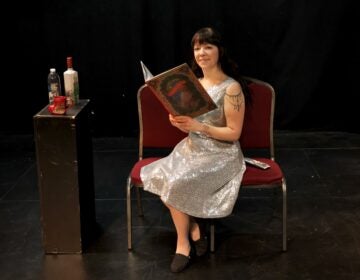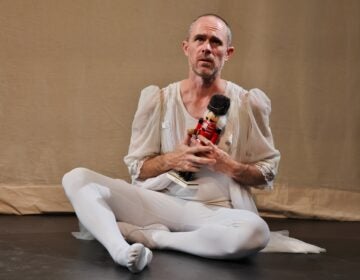Photographer evokes ‘Ephemeral Existence’ in images of urban Japan
As Japan reels from the aftershocks of its devastating earthquake, an art gallery in Rittenhouse Square is exhibiting large-scale photographs showing Japan’s industrial landscape.
The images at 339 Gallery were taken at night and portray massive constructions of steel and concrete as a dreamscape. They hang in poignant contrast to images of the disaster flooding the media for the last month.
Photographer Tetsugo Hyakutake grew up in Kawasaki, a heavily industrial city near Tokyo. After the annihilation during World War II, the city was critical to Japan’s miraculous economic growth. But it became one of Japan’s most toxic sites.
Bathed in eerily soft, fluorescent light, Hyakutake’s photos show dock cranes, railroad hubs, and concrete bridges at their most beautiful. But that beauty masks an eroding social fabric.
“After we became rich, we lost a lot of things– family, communication, nobody cares for each other. I was kind of sad to see current Tokyo,” said Hyakutake, who studied photography in Philadelphia at the University of the Arts and the University of Pennsylvania. “But after the earthquake took place, people took care of each other. I tried to see this earthquake as a turning point to reveal post-disaster Japan.”
Hyakutake made the pictures on large-format cameras with 4-by-6-inch negative film–some were taken on enormous 8-by-11-inch negative–at night. To get enough light onto the film he would have to leave the lens open for up to an hour per exposure. “I failed a lot, and wasted a lot of film,” he said.
The images that worked have incredibly crisp detail hung with heavy, hazy light that seems to cling to surfaces as though viscous. Distances between objects become flattened, so concrete pillars, rows of steel shipping containers, office buildings, and residential apartment complexes seem to share the same space.
That’s the point, said Hyakutake. There is almost no distinction between residential, office, and industrial. The country has little space to spare.
The Japanese industrial sites hold conflicted fascination for Hyakutake. They represent the hubris of solidity on the one hand; on the other are repercussions upon a fragile social and environmental balance. The exhibit is called “Ephemeral Existence.”
“Our economic prosperity is ephemeral,” said Hyakutake, who never trusted the economic miracle. “I knew an earthquake would hit Tokyo–everyone knew it–but this was way too much. I feel I have to go back to these sites, to feel something there.”
Hyakutake has not been in Japan since the earthquake–since January he’s been at an artist residency program in Rotterdam.
Hyakutake is not a photojournalist. When he returns to Japan next week, he will visit the disaster sites in the north, but he may not bring his camera at first. He says he needs to see it, and ponder.
WHYY is your source for fact-based, in-depth journalism and information. As a nonprofit organization, we rely on financial support from readers like you. Please give today.




